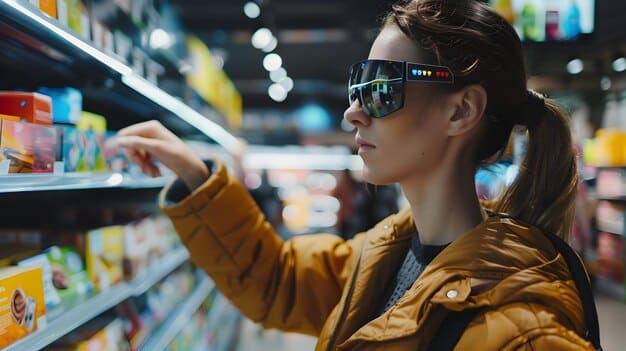The Future of Couponing: Trends and Tech for 2025

The future of couponing in 2025 is set to be greatly influenced by advanced digital technologies and personalized strategies, transforming traditional savings methods into more dynamic, efficient, and user-centric experiences.
As we approach 2025, the landscape of consumer savings, particularly through coupons, is undergoing a profound transformation. What was once primarily a paper-based endeavor is rapidly evolving into a sophisticated digital ecosystem, driven by technological advancements and shifting consumer behaviors. This evolution promises to redefine how shoppers access deals and how retailers engage with their clientele, making The Future of Couponing: Exploring the Latest Trends and Technologies in 2025 a fascinating subject for anyone interested in retail, technology, or personal finance.
The Digital Revolution: From Clipping to Clicking
The transition from physical paper coupons to digital formats has been a gradual but persistent force in retail, fundamentally altering how consumers interact with promotional offers. This shift is not just about convenience; it’s about integration into a seamlessly connected shopping experience. The ubiquity of smartphones and the continuous advancements in mobile technology have paved the way for coupons to become an integral part of the digital wallet, accessible anytime, anywhere.
Consumers no longer need to meticulously clip coupons from newspapers or sort through junk mail. Instead, they can effortlessly browse deals on their devices, activate offers with a tap, and redeem them at checkout, often without even presenting a physical card. This direct access streamlines the saving process, removing barriers that once deterred casual coupon users and empowering them with instant access to discounts.
Mobile-First Strategies and App Integration
Mobile applications have become the primary conduit for digital coupon delivery and redemption. Major retailers, grocery chains, and even small businesses are investing heavily in their own dedicated apps, providing an integrated platform for coupons, loyalty programs, and personalized offers. These apps often feature intuitive interfaces, allowing users to easily search for deals, create shopping lists, and track their savings.
- 📱 In-app coupon activation and redemption
- geolocation-based alerts for nearby deals
- Loyalty program integration for enhanced rewards
- Seamless digital wallet functionality
Beyond individual retailer apps, third-party coupon aggregators and financial apps are also playing a crucial role. These platforms consolidate deals from various sources, presenting a comprehensive view of available savings across different stores and product categories. Their widespread adoption underscores a consumer demand for centralized, easy-to-use solutions that maximize their savings potential.
Looking ahead to 2025, the mobile-first approach is expected to intensify. Expect more sophisticated app features, including augmented reality (AR) for in-store deal discovery and enhanced voice command functionalities for hands-free coupon management. The synergy between mobile technology and couponing will continue to drive innovation, making savings more intuitive and integrated into daily life.
The digital revolution in couponing is far more than a simple technological upgrade; it represents a paradigm shift in consumer behavior and retailer strategy. By embracing digital platforms, businesses can reach a wider audience, gather valuable data on consumer preferences, and offer a more dynamic, engaging, and personalized shopping experience, all while providing the savings consumers actively seek.
Personalization and AI: Tailoring Deals to Individuals
The era of one-size-fits-all coupons is rapidly fading, replaced by a sophisticated understanding of individual consumer preferences and purchasing habits. Artificial Intelligence (AI) and machine learning are at the forefront of this revolution, enabling retailers to deliver highly personalized deals that resonate deeply with each shopper. This level of customization transforms couponing from a generic discount offering into a powerful tool for customer engagement and loyalty.
AI algorithms analyze vast quantities of data, including past purchases, browsing history, demographic information, and even real-time location data. By correlating these insights, AI can predict future purchasing needs and present coupons for products that a consumer is most likely to buy, or for complementary items that enhance their shopping experience. This predictive capability increases the relevance of each offer, significantly boosting redemption rates and perceived value for the consumer.
Data-Driven Strategies and Predictive Analytics
The foundation of effective personalization lies in meticulous data collection and analysis. Every click, every purchase, every interaction provides a piece of the puzzle that helps AI build a comprehensive profile of the consumer. This data, anonymized and aggregated, allows retailers to identify patterns and trends that inform their coupon strategies. For instance, if a customer frequently buys pet food, AI can trigger a coupon for a new brand of pet treats or accessories.
- 📈 Analyzing historical purchase data for trends
- 🌐 Leveraging browsing and search behavior for intent signals
- 📍 Utilizing geolocation for proximity-based offers
- 🧠 Building predictive models for future needs
Predictive analytics takes this a step further, anticipating future consumer needs or even potential churn. By forecasting, for example, when a specific household item might run out, retailers can proactively offer a coupon just as the need arises, effectively positioning themselves as helpful, anticipatory partners rather than just discount providers.
The precision afforded by AI also means less wasted marketing spend for businesses. Instead of broadcasting generic offers to a broad audience, they can target their promotions to the most receptive segments, optimizing their return on investment. For consumers, this translates into a less cluttered inbox and an experience where virtually every coupon feels tailor-made for them.

By 2025, the sophistication of AI in couponing is expected to integrate even deeper into the shopping journey. Imagine smart refrigerators that detect low stock and automatically ping your phone with coupons for those items, or voice assistants that suggest deals based on your meal plans. The potential for AI to create a truly seamless and hyper-personalized couponing experience is immense, blurring the lines between convenience, savings, and anticipatory service.
The synergy between personalization and AI is transforming couponing into a highly intelligent and user-centric art. It’s about more than just saving money; it’s about feeling understood and valued by retailers, fostering a sense of loyalty that extends far beyond the immediate transaction. This evolution underscores a future where every deal feels like it was crafted just for you.
Blockchain and Security: Building Trust in Transactions
In an increasingly digital world, the integrity and security of online transactions are paramount. For couponing, this translates into ensuring that offers are authentic, redeemed only once, and that consumer data is protected. Blockchain technology, initially known for its role in cryptocurrencies, offers a robust framework for achieving this level of trust and transparency in the couponing ecosystem.
At its core, blockchain is a distributed, immutable ledger. Every transaction, including the issuance and redemption of a coupon, is recorded on this ledger in a way that cannot be altered or duplicated. This inherent security eliminates common problems associated with traditional couponing, such as fraud, double-dipping, and unauthorized distribution, thereby protecting both consumers and retailers.
Ensuring Authenticity and Preventing Fraud
Coupon fraud costs retailers billions of dollars annually, ranging from counterfeit coupons to improper redemption. Blockchain provides a powerful deterrent by creating unique, verifiable digital tokens for each coupon. When a coupon is issued, it’s recorded on the blockchain; when it’s redeemed, that action is also recorded, marking the token as used. This real-time, transparent tracking makes it virtually impossible to use a coupon more than once or to create fake ones.
- 🔒 Immutable records for each coupon transaction
- 🚫 Prevention of duplicate redemptions
- ✅ Verification of coupon authenticity
- 🛡️ Enhanced data integrity and transparency
For consumers, this means greater assurance that the coupons they receive are legitimate and will be honored. For businesses, it translates into significant cost savings by mitigating losses due to fraudulent activity. Moreover, the transparency of blockchain can provide valuable insights into coupon usage patterns, helping retailers refine their strategies with accurate data.
Beyond fraud prevention, blockchain can also enhance the security of consumer data. While coupon redemption data is recorded, the personal identities of consumers can be kept private through cryptographic techniques. This “zero-knowledge proof” functionality allows for verification of a redeemed coupon without revealing sensitive personal information, fostering greater trust in the data-sharing process.
By 2025, we anticipate a greater adoption of blockchain solutions within the couponing industry, particularly for high-value offers or in ecosystems where multiple parties are involved (e.g., brand manufacturers, retailers, and coupon aggregators). Smart contracts, an extension of blockchain technology, could also automate the terms and conditions of coupons, ensuring that specific rules (like minimum purchase amounts or expiry dates) are automatically enforced upon redemption.
The integration of blockchain technology into couponing represents a significant leap forward in security and trust. It provides a foundational layer of integrity that addresses long-standing challenges in the industry, benefiting both consumers through guaranteed legitimate offers and retailers through reduced fraud and more reliable data. This evolution is vital for building a secure and trustworthy savings environment in the digital age.
Experiential Couponing: Beyond Basic Discounts
The future of couponing extends beyond mere monetary savings; it’s increasingly about creating memorable and engaging experiences for the consumer. In a highly competitive market, retailers are realizing that a discount alone might not be enough to capture attention or build lasting loyalty. Experiential couponing aims to transform the act of saving into an interactive, rewarding, and even entertaining part of the shopping journey.
This trend leverages technology to deliver offers that are dynamic, context-aware, and often gamified. Instead of a static discount, consumers might unlock a special offer by completing a challenge, participating in a survey, or interacting with a brand in a unique way. This adds an element of fun and discovery, making the coupon not just a means to an end, but a part of a broader, enjoyable brand interaction.
Gamification, AR, and VR in Coupon Redemption
Gamification is a powerful tool in experiential couponing, turning coupon discovery and redemption into a playful pursuit. Retailers can introduce elements like loyalty points for engaging with content, daily challenges that unlock exclusive deals, or even virtual scavenger hunts within their apps or stores that lead to special discounts. This taps into the human desire for achievement and reward, encouraging deeper engagement with the brand.
- 🎯 In-app challenges unlocking exclusive coupons
- 🕹️ Interactive games providing tiered discounts
- 🌟 Loyalty point systems tied to coupon redemption
- 🏆 Leaderboards for top savers or brand advocates
Augmented Reality (AR) and Virtual Reality (VR) are set to revolutionize in-store experiential couponing. Imagine using your smartphone to scan a product and instantly see a virtual overlay displaying coupon eligibility, product reviews, or even a mini-game that offers a discount if you “catch” virtual items. VR could offer immersive brand experiences where users explore virtual stores and discover hidden deals within a simulated environment.

Live events and pop-up experiences can also be integrated with experiential coupons. Attendees might receive limited-time, personalized offers delivered directly to their mobile devices, redeemable only during the event or for a short period afterward. This creates a sense of urgency and exclusivity, driving immediate engagement and purchase.
By 2025, the line between entertainment, marketing, and savings will become increasingly blurred. Experiential couponing will not just save consumers money, but also enrich their shopping experience, making it more personal, interactive, and memorable. This evolution is crucial for brands looking to differentiate themselves and build strong, emotional connections with their customers in a competitive retail landscape.
Ultimately, experiential couponing elevates the simple act of saving into a multifaceted brand engagement. It moves beyond transactional relationships to foster loyalty built on positive experiences, creativity, and a sense of shared value between consumer and retailer.
Subscription Models and Premium Access
The future of couponing is also seeing a notable shift towards integrated subscription models, offering consumers premium access to exclusive deals and enhanced savings. This evolution reflects a broader trend in the consumer market, where subscription services are becoming a preferred method for accessing content, products, and now, even discounts. For retailers, it represents a stable revenue stream and a powerful tool for cultivating deeply loyal customer bases.
Instead of relying on sporadic coupon drops, consumers can opt into a paid subscription that provides a continuous stream of high-value offers, early access to sales, or even compounding discounts. These models often go beyond simple percentage off deals, including perks like free shipping, priority customer service, or special member-only events, making the subscription an attractive proposition for frequent shoppers.
Membership Programs and Exclusive Perks
Many retailers are refining their loyalty programs to include tiered membership levels, where premium tiers are unlocked through a subscription fee. These premium levels offer significantly better coupon benefits compared to standard membership. This could mean higher discount percentages, access to coupons for luxury items, or even “stackable” coupons that can be combined for maximum savings.
- 💎 Access to exclusive, high-value coupons
- 📦 Free or expedited shipping on all orders
- 🚀 Early access to sales and new product launches
- 🤝 Priority customer support
For consumers, the appeal lies in predictable savings and a feeling of exclusivity. Knowing that they have a steady flow of superior deals can simplify their shopping decisions and encourage them to shop more frequently with a particular brand or retailer. For businesses, subscription models provide invaluable data on committed customers, allowing for even more precise personalization and product development based on the needs of their most valuable clientele.
Beyond retailer-specific subscriptions, we might also see the rise of independent coupon subscription services—platforms that curate and deliver premium deals from multiple brands for a monthly fee. These services would appeal to extreme couponers and savvy shoppers looking to maximize their savings across a broad spectrum of purchases without investing time in searching for individual deals.
By 2025, these subscription-based couponing models are likely to become more sophisticated, potentially integrating with other smart home devices or personal finance apps to automatically apply the best available savings for subscribers. The value proposition will continue to expand, offering a comprehensive suite of benefits that extend far beyond just monetary discounts, fostering a true sense of partnership between consumers and their preferred retailers.
This move towards subscription and premium access reinforces the idea that savings can be a service in itself. It elevates couponing from a mere transaction to a valued membership, cementing customer loyalty and offering a more stable and predictable path to savings for the consumer, all while providing a consistent revenue stream for businesses.
Sustainable Couponing and Ethical Consumption
As consumer awareness around sustainability and ethical consumption grows, the future of couponing is also adapting to reflect these values. Beyond merely offering discounts, coupons are now being used as tools to encourage environmentally friendly choices, support local businesses, and promote products that align with ethical production standards. This trend moves couponing beyond purely financial incentives to encompass a broader social and environmental impact.
This approach involves offering discounts on eco-friendly products, promoting circular economy initiatives (like discounts for returning packaging or recycling), and encouraging purchases from brands committed to fair trade or sustainable sourcing. It’s a strategic move that aligns with modern consumer values, helping businesses not only attract ethically-minded shoppers but also bolster their corporate social responsibility image.
Promoting Eco-Friendly and Local Choices
Coupons can be powerful nudges towards more sustainable behaviors. For example, a discount on public transport fares could encourage reduced car usage, or a coupon for reusable bags could reduce plastic waste. Retailers might offer special deals on locally sourced produce, supporting community economies and reducing carbon footprints associated with long-distance transportation.
- 🌱 Discounts on organic and sustainably sourced products
- ♻️ Offers for recycling programs or refilling stations
- 🌍 Promotions for products with lower environmental impact
- 🏘️ Coupons supporting local businesses and artisans
Furthermore, some brands are designing coupons that specifically promote products with certifications for fair labor, cruelty-free production, or reduced packaging. This not only highlights their commitment to ethical practices but also educates consumers on how their purchasing decisions can make a positive difference.
The digital nature of modern coupons also inherently contributes to sustainability by reducing paper waste. As more consumers opt for digital-only deals, the environmental impact of printing, mailing, and disposing of traditional paper coupons diminishes significantly. This transition supports a cleaner, greener approach to promotional activities.
By 2025, expect to see an even greater integration of sustainability metrics into coupon design and distribution. Consumers may be offered tiered discounts based on the eco-friendliness of their entire basket, or receive bonus coupons for participating in brand-sponsored clean-up drives. The concept of “green couponing” will likely become a distinct and growing segment within the broader couponing landscape.
Sustainable couponing transcends traditional cost-saving. It connects consumer savings with broader societal values, demonstrating how economic incentives can be leveraged to foster more responsible consumption habits. This evolution positions coupons not just as a tool for personal finance, but as a catalyst for positive environmental and social change.
The Integration with Emerging Technologies
Beyond AI, blockchain, and AR/VR, the future of couponing is poised to embrace an even wider array of emerging technologies, creating a truly seamless and intelligent savings ecosystem. These advancements promise to make coupon discovery and redemption nearly effortless, embedding savings opportunities into our daily lives in ways that were once considered futuristic.
The Internet of Things (IoT), voice commerce, and even advanced biometric authentication are all on the horizon, each offering unique avenues to enhance the couponing experience. This convergence of technologies will enable a level of automation and convenience that truly distinguishes the next generation of couponing.
IoT, Voice Commerce, and Biometric Integration
The Internet of Things (IoT) holds immense potential for contextual coupon delivery. Imagine smart refrigerators that detect low stock on milk and automatically search for and apply a digital coupon at your preferred grocery store when you add milk to your cart. Or smart speakers that, upon hearing you mention a product you’re considering buying, proactively suggest available coupons.
- 🗣️ Voice-activated coupon search and application
- 🏠 Smart home device integration for contextual deals
- 👁️ Biometric authentication for secure, touchless redemption
- 🚘 In-car commerce offering deals based on location
Voice commerce is rapidly gaining traction, and couponing is a natural fit. Consumers could simply ask their voice assistant, “Are there any coupons for coffee?” and receive relevant offers vocally, which could then be sent directly to their digital wallet or applied to an online order. This hands-free approach simplifies the search for deals, making it accessible even when multitasking.
Biometric authentication, such as fingerprint or facial recognition, will contribute to faster and more secure coupon redemption. Instead of scanning a barcode or typing in a code, consumers could simply use their face or fingerprint at checkout to apply all eligible digital coupons. This not only speeds up the process but also adds a robust layer of security against unauthorized use.
By 2025, it’s conceivable that personalized coupons could be pushed directly to your smart glasses as you walk past a store, or automatically applied to subscriptions based on your usage patterns detected by IoT devices. The goal is to move couponing from a discrete action to an ambient, intuitive part of the consumer experience, where savings are seamlessly integrated into every interaction.
The integration of these emerging technologies signifies a future where couponing is not just about discounts, but about intelligent, proactive, and effortless value addition. It turns savings into a truly integrated and almost invisible part of the modern connected lifestyle, enhancing convenience and efficiency for the savvy consumer.
| Key Trend | Brief Description |
|---|---|
| 📱 Digital Dominance | Coupons shift almost entirely to mobile apps and digital platforms for seamless access. |
| 🤖 AI Personalization | AI tailors deals based on individual purchasing habits for maximum relevance. |
| 🔗 Blockchain Security | Ensures authenticity and prevents fraud, building trust in digital transactions. |
| 🎮 Experiential Savings | Gamified offers and AR/VR integration make couponing interactive and engaging. |
Frequently Asked Questions about the Future of Couponing
▼
While digital coupons will dominate, paper coupons are unlikely to disappear completely by 2025. They may continue to serve niche markets or specific demographic groups who prefer traditional methods. However, their prevalence will significantly decrease, becoming a lesser component of the overall couponing landscape compared to their digital counterparts.
▼
AI’s impact on privacy depends on how data is handled. While AI enables hyper-personalization, reputable companies are expected to use anonymized and aggregated data, adhering to strict data protection regulations. Consumers will increasingly have more control over their data preferences, choosing what information they share for personalized offers.
▼
Blockchain offers a significant leap in preventing coupon fraud by creating immutable, verifiable records for each coupon. While no system is entirely foolproof, blockchain’s inherent security features make it exceptionally difficult to counterfeit or double-redeem coupons, drastically reducing the opportunities for fraudulent activities compared to current systems.
▼
“Experiential couponing” blends discounts with interactive experiences. You might encounter it through in-app games that unlock deals, augmented reality overlays in stores showing special offers, or even personalized discounts triggered by your participation in brand challenges or surveys, making saving more engaging than just a price reduction.
▼
While free coupons will still be available, the trend suggests a rise in premium, subscription-based coupon services offering exclusive, higher-value deals or added perks. These paid models are designed for power users or those seeking maximum savings and convenience, but traditional free coupon options will likely continue to coexist.
Conclusion
The journey into The Future of Couponing: Exploring the Latest Trends and Technologies in 2025 reveals a dynamic landscape where savings are no longer just about cutting costs, but about enhancing the entire consumer experience. From sophisticated AI-driven personalization and the unwavering security offered by blockchain to the playful engagement of experiential couponing and the responsible shift towards sustainable practices, the couponing industry is set for a profound transformation. As technology continues to evolve, coupons are becoming seamlessly integrated into our daily lives, making savings more accessible, relevant, and engaging than ever before. This exciting evolution promises a future where smart shopping is not just a strategic choice, but an intuitive and rewarding part of the modern consumer’s journey.





